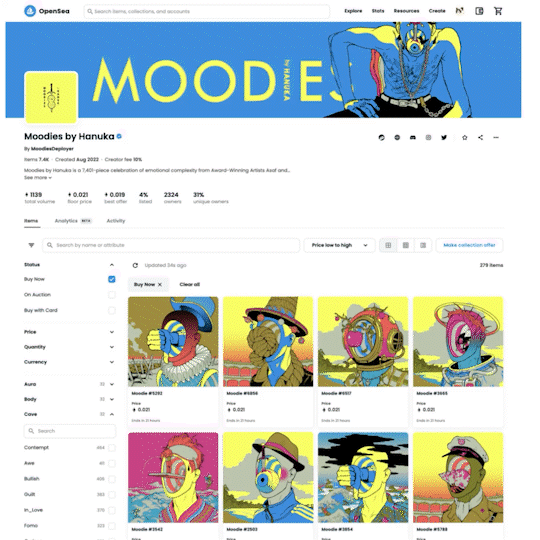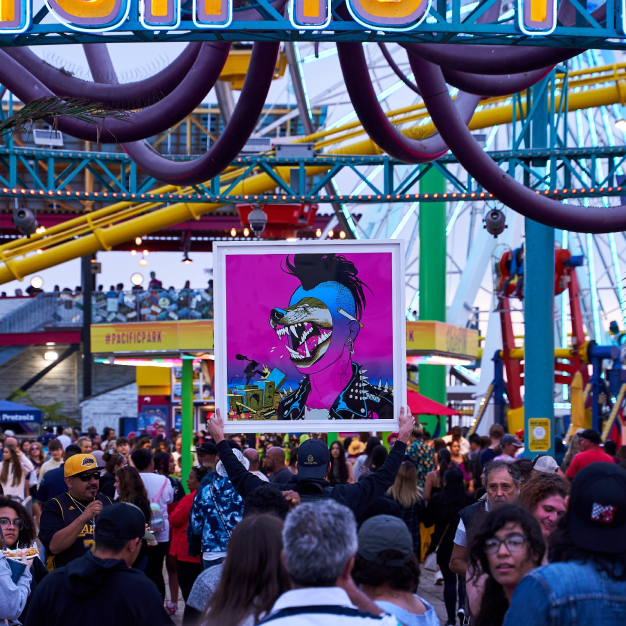Pau Waelder

The NFT revolution has brought an unprecedented attention to digital art, which is now easier to collect than ever before: once you sync your wallet to the marketplace, you only need to browse, pick your favorite NFTs, and in two clicks you’re the proud owner of a rare gem that just dropped. It is so easy that many collectors have hundreds, if not thousands, of digital artworks in their wallet. The excitement of owning something beautiful and unique, paired with the immediacy of the transaction, can become addictive. As the collection grows, it fills row after row of an endless grid that you can see on any web browser. With a simple copy and paste, you can also share your collection with anyone and brag about your possessions, your taste, or your ability to seize the opportunity and get that coveted artwork that is now out of reach of most wallets.
The excitement of owning something beautiful and unique, paired with the immediacy of the transaction, can become addictive. As the collection grows, it fills row after row of an endless grid that you can see on any web browser.
In the heyday of its market boom, NFTs were seen as quick investments that provided those who arrived earlier and were faster to collect an opportunity to multiply their earnings by buying and reselling quickly: this is what in the art market lingo is known as “flipping.” But art flippers are frowned upon in the art world: what artists, galleries, and also art lovers want are serious collectors. A serious collector is someone who buys art out of a deep appreciation for the artwork, and wants to keep it. Someone who likes to support artists and learn from their work, and obviously someone who enjoys experiencing the artwork, not just storing it somewhere.
As the NFT market has begun to attract serious collectors, a specific question has risen to the surface: how to display the NFTs in your collection? This is a concern that was usually ignored by those who intended to keep the artwork in their wallet for just a few minutes. But now that art flippers, discouraged by the drop in value of cryptocurrencies and many hyped collectibles, have begun to look elsewhere for investments, those who remain and are really interested in the art they collect are considering how to enjoy the artworks as they would if they owned a painting or a sculpture.
From browser to room
Typically, marketplaces focus on providing artworks for sale and securing the transactions. They can also provide additional files that only the owner of the NFT can access, countering the argument “why buy something anyone can download?. In some cases, the platform is not just an endless grid displaying every artwork that users have uploaded, but something more. This is, for instance, the case of Feral File, which features NFTs in curated selections that focus on a particular subject or format, and put together artworks by emerging and established artists, oftentimes produced specifically for the platform. Feral File also stands out from other marketplaces in that it provides collectors with detailed information about each artwork, its format, and the associated files that will be transferred after the sale. As I mentioned in a previous article, it is very important to know exactly what you are getting when you buy an NFT.
Beyond securing the means to collect NFTs and preview them in their own website, most marketplaces do not offer any means for collectors to display the artworks they own elsewhere. Here again, Feral File is an exception with the development of the smartphone app Autonomy, which allows bringing to a single interface all NFTs collected in different wallets, on Ethereum or Tezos, and viewing them on the device’s screen. The artworks are collected from their IPFS addresses, which at first might cause some delays in loading and viewing the artworks, particularly for a large collection. The app also offers the possibility of connecting to a smart TV or projector and viewing a single artwork on a screen of projected surface, although this relies on a previous synchronization with the device that is not always easy to achieve: while Chromecast and AirPlay are increasingly used, not all screens and projectors support them properly. Solutions like Autonomy respond to the need that NFT collectors have of managing their collection and displaying the artworks, but they are still not fully developed.
Niio has a robust system for storing and managing collections of video and digital art, that is paired with a curated art program, and an app for iOS, Android, and Apple TV, also directly available on Samsung and LG screens, that allows to display a continuous stream of artworks, full collections, and curated selections with information about the art and the artists. The system also provides full integration with NFT collections by allowing users to synchronize their wallets and import the NFTs to their Vault, where a copy of the IPFS stored file is saved and can be immediately displayed on any screen using the Niio app. In this manner, the solution provided by Niio finally fills the gap between buying an artwork minted as an NFT and enjoying it on a high resolution screen at home, or anywhere. Once the wallet is connected to the collector’s personal account, they can buy NFTs on any marketplace, choose which ones to store in their private vault, create their own playlists, and view them in the app or on a screen.
This is the future of collecting, as gallery owners Valérie Hasson-Benillouche (Charlot, Paris) and Wolf Lieser (DAM, Berlin) recently pointed out: collectors are traveling a lot, and they like to have their collection with them, and also to share it with others. This brings a different way of buying art, as it is not only meant to be placed somewhere, but it becomes part of the collector’s daily life and interactions with others, wherever they go.

Formats and behaviors
A question that comes out when displaying NFTs usually is: how do I display my square NFT in a 16:9 screen? Certainly this is a common issue due to the paradoxical fact that TVs have evolved from being square to rectangular, while digital art, that usually adopts the format of a screen in portrait or landscape orientation, has usually adopted square formats in the NFT market. The explanation for NFTs being square can be found in the grid established by most marketplaces, which has become the field of battle where artists compete to show their work, the latter being limited to a square thumbnail. The square format has also proven to be the most successful on social media, and particularly apt for PFP collections, the type of art that one buys to use as a profile picture and signal one’s belonging to a community defined by a particular NFT project such as CryptoPunks, Bored Ape Yacht Club, or more recently, Moodies by Hanuka.
While some square frames exist, not all artworks minted as NFTs follow this rule, so it is up to each collector to decide whether to use a regular screen for all the art they own, or find a place for an additional screen in this particular format. Certainly, just as most collectors have artworks in different sizes that fit certain spaces of their homes, it is possible to have a series of screens (one in landscape orientation, another one in portrait orientation, and finally a square screen) to display different kinds of artworks. In this case, it is important to use a system that allows controlling the art displayed on all of the screens from one app, which is something that Niio can uniquely do.
Just as most collectors have artworks in different sizes that fit certain spaces of their homes, it is possible to have a series of screens to display different kinds of artworks
Not all NFTs are the same or have the same purpose. As previously mentioned, some are meant to be used as a profile picture or distributed online, which does not mean they can´t also be displayed on the wall. But others have a particular behavior, they can be generative, or interactive, which means they require a software to run continuously and sometimes an input in the form of a mouse click, movement captured by a camera, and so forth. Digital art has many forms beyond what is usually associated with NFTs, and since artists can mint any digital artwork as an NFT, it must be remembered that some can only be experienced with a specific software and hardware setup. In these cases, the collector must take into account that they need to setup a computer with the software provided by the artist, and connect it to a screen. Some companies, such as FRAMED*, sell a digital frame with an integrated computer that can run software-based artworks, but the collector must make sure that the software of the artwork they own is compatible with this type of device, as well as the size and orientation of the screen (FRAMED* currently sells a device named Mono X7 which is a 17.3-inch portrait orientation display). For video artworks, there are also solutions like Infinite Objects, which provide a customized small screen to display a single video in a continuous loop. Described as “video prints,” these screens have been used by some artists to turn an NFT into a unique object.

A collection that lasts
The NFT space wants serious collectors that do not engage in art flipping and hold to the art they own. But collectors also demand a lasting solution for their art collections, which at first the NFT art market, immersed in constant dropping and transacting, did not care much to provide. Most NFTs are stored in IPFS, a peer-to-peer network system that is expected to keep artwork files safe and at the same time publicly available. However, the best option to ensure that one will be able to preserve the artwork is to download the file and keep copies in different locations. This is particularly true for unlockable content that is only available to collectors and usually consists of larger files and additional material. Most marketplaces rely on links to IPFS and store unlockables in their servers, but a safer choice is to keep everything at hand, in a private space. Niio provides collectors with a vault where they can store the artworks and manage all the information about them, including additional files that will be kept private and can always be downloaded. The artwork can be displayed and shared, but it is also securely stored.
Most marketplaces rely on links to IPFS and store unlockables in their servers, but a safer choice is to keep everything at hand, in a private space.
NFTs show that art collecting is entering a new phase in which collectors want flexibility, ease of use from their smartphone or any other connected device, and the ability to take their collection anywhere. But they still want reliability and a way to safely preserve their artworks. The solution that aptly responds to all of these needs will become the standard in the art world.
